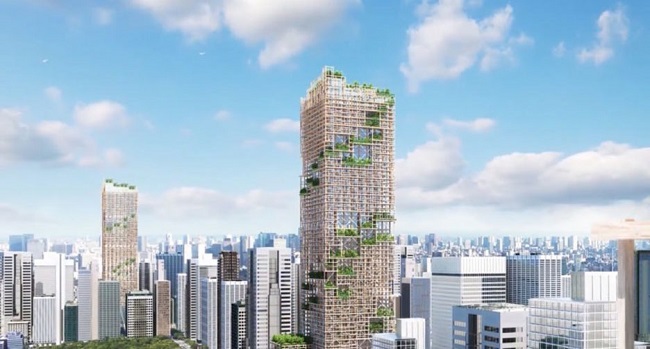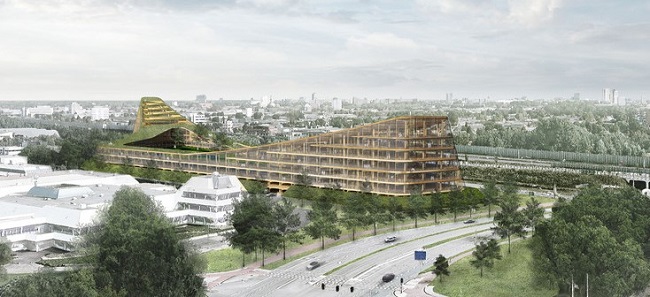With the development of new techniques, wood is now being used to build skyscrapers and recent months have seen a surge in large timber structures being constructed across the globe claiming to be the biggest, the tallest, or the first of their kind. But observers are worried about the impact of the trend on the environment.

No fewer that seven of these structures located across Europe, Asia and North America are either still on the drawing board, under construction or already in existence.
Some of these are the “Dutch Mountains” in Veldhoven, Eindhoven, The Netherlands; “W350” in Tokyo, Japan; “Treet” in Bergen, Norway; “Mjøstårnet” in Brumundal, Norway; “Oak Timber Tower” in London, UK; “HoHo Tower” in Vienna, Austria; and “Brock Commons Student Residence” in Vancouver, Canada.
Touted as the “largest wooden building in the world”, the Dutch Mountains was conceived via a multi-disciplinary partnership made up of tech companies, service providers, architects and developers, and would contain a hi-tech, mixed-use programme for residents and visitors.
The W350 is a 70-storey, 350-metre skyscraper that would also be Japan’s tallest building on completion in 2041. Designed by Sumitomo’s Tsukuba Research Laboratory in collaboration with Tokyo practice Nikken Sekkei, the $5.9 billion multi-use tower containing a hotel, residential units, offices, and shops would be wrapped in large balconies covered in plants.
W350 would be almost four times higher than the world’s current tallest timber building – the 18-storey Brock Commons Student Residence in Vancouver. But the tallest wooden skyscraper in the world is soon to emerge in 2018: the 24-storey, multi-purpose HoHo Tower stands at 84 metres with 76 percent of the building made from timber.

One of the current claimants of the world record for the tallest timber building is Treet in Norway, which stands at 51 metres tall, even the though the Mjøstårnet is set to reach an even taller height of 81 meters. Construction of Mjøstårnet began in early September and is due for completion in March 2019.
Even though proponents of the technology claim that it is sustainable and reduces the carbon footprint compared with the conventional method, some environmentalists however remain sceptical.
Wood has long been a favoured construction material, noted for being durable, lightweight and inexpensive. In fact, Japan’s government passed a law in 2010 promoting the sustainable use of wood in all public buildings up to three stories high.
But architect and environmental activist, Nnimmo Bassey, says cutting trees for large building structures will intensify the creation of plantations or cause deforestation.
“These compound climate and social crises,” he adds, pointing out that plantations “are bad news for the climate”.
“Many of them are planted after clearing and felling of trees. Plantations are not only bad for the climate, they are bad for communities who lease land and biodiversity,” he notes, adding:
“Let me state clearly that high rise timber structures pose unique risks and should be erected with full understanding of such risks. Topmost risk is that of fire. Consider if such structures were in the line of the raging fires in California, for example.”
A forestry, environmental as well as research & development (R & D) expert, Dr David Ladipo, also frowns at the development, saying that to use wood so intensively is not sustainable beyond research or exhibition level.
His words: “This system of 70 to 90% wood in structures such as buildings will drive forest or tree felling to its brink and accentuate our environmental problems the more. If the lumber will be sourced from Japan and Switzerland or any other place in Europe and Asia, their forests will be exhausted.
“Unfortunately, all the wood will come from Africa and the developing world, as the Chinese are presently exploiting our wood massively in Nigeria. Africa already has its problems of deforestation, charcoal production, climate change, poor agriculture yield, etc. Further exploitation of its forests will further warm the continent and have a telling effect on the developed world.
“So, the world should frown against the massive use of timber. Instead, they should use utilise reconstituted timber/wood, which is made from sawdust and cement. They should also source the wood from elsewhere and not from Africa.”
While Prince Lekan Fadina of the Centre for Investment, Sustainable Development, Management & Environment (CISME) expressed concern over “the loss of cover which the trees provide and the loss of the economic benefit and the impact on the environment and sustainable livelihood”, Ako Amadi of the Community Conservation and Development Initiatives (CCDI) on the other wonders if the construction is utilising forest hardwood or plantation timber like teak.
“No problem if it’s teak as it is grown in plantations even in Nigeria with the purpose of using its timber,” adds Amadi.
Some parties are however not entirely against the development.
“Wood is a renewable resource so if it could be sustainably harvested, it could be a suitable replacement for cement, a product with high carbon emissions during production,” submits Chike Chikwendu, engineer and head of the Centre for Energy and Environmental Sustainability.
“Norway is already pioneering a 10-storey wooden building. I have not gone through the details, but my expectation is that selective cutting and replanting of wood would be the sustainability means. The wood will not be sourced from outside. It will be nice to get the project concept,” contends Prof Olukayode Oladipo of the University of Lagos, Akoka.
Prof. Daniel Gwary of the University of Maiduguri states: “From the surface, this development looks worrisome in terms of carbon sequestration point of view. However, it is important to note some important things. First, house and general construction work round the world using wood is not new but has been going on for centuries at a sustainable scale. For trees to serve as effective sinks, they need to be managed and part of the management process is pruning and replacing older trees with young ones.
“Secondly, for countries like Japan that are in earthquake zones, they require lighter building materials for safety and wood is four times lighter than concrete therefore is a preferred building material.
“Thirdly, the Japanese company building the 70-storey skyscraper, the Sumitomo Forestry Co Ltd, is a forestry-architectural outfit that is committed to GHG emission reduction and intends to use wood from old forest planted soon after the world war. This is to be part of the forest management strategy.
“Finally, with reduced global use of paper due to new information technology (IT) it is argued that this new limited demand for wood for construction may be sustained with good plan.”
